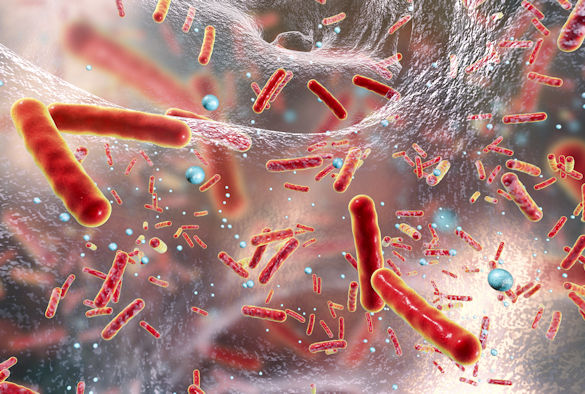A new study published today in Nature Communications, led by scientists at the University of Liverpool in collaboration with the University of Salford, finds evidence that as bacteria adapt to the human body, they can sometimes become more susceptible to antibiotics and therefore easier to kill.
Antibiotic medications are used to kill bacteria, which can cause illness and disease. They have made a major contribution to human health. Many diseases that once killed people can now be treated effectively with antibiotics. However, some bacteria have become resistant to commonly used antibiotics.
Antibiotic resistant bacteria are bacteria that are not controlled or killed by antibiotics. They are able to survive and even multiply in the presence of an antibiotic. Most infection-causing bacteria can become resistant to at least some antibiotics. Bacteria are increasingly becoming antibiotic-resistant, making infections such as pneumonia, tuberculosis harder to treat, leading to increased medical costs, prolonged hospital stays and higher mortality.
Opportunistic organism
Pseudomonas aeruginosa is a species of bacteria that is able to survive in harsh environments. It is found widely in soil and stagnant water, and can infect humans and plants. It does not usually cause illness in healthy people, but is described as an ‘opportunistic’ organism, causing serious infection when our normal defences are weakened. It is a major cause of lung infections, particularly in patients with cystic fibrosis.
Researchers aimed to establish how the bacteria adapted to the environment of the lungs and whether this process impacted on bacterial resistance to antibiotic treatment.
Using models of long-term lung infection, the team identified mutations that appeared in the bacterial DNA over the course of infection and which led to changes in the ability of Pseudomonas to survive in the lungs. The mutations enabled the bacteria to attach to lung cells more effectively, and to resist defence molecules produced by the host immune system.
Importantly however, the same changes also made Pseudomonas more susceptible to antibiotics, raising hopes that even bacteria that are well adapted to the lung environment could be combatted with conventional antibiotics. The new study, published today (July 6 2018), sheds new light on how bacterial pathogens can change over the course of a single infection within a patient.
Cost of adaption
Dr Daniel Neill, part of the team that led the study at the University of Liverpool, explains: “For a bacterium like Pseudomonas aeruginosa to survive in the lungs, it needs to adapt quickly. The human body contains an array of defences that will quickly kill bacteria if they cannot find ways to protect themselves. The mutations we identified in Pseudomonas in this study were important in allowing the bacteria to resist an anti-bacterial enzyme of the host immune system called lysozyme. What surprised us was that this adaptation came at a cost, in that bacteria carrying the mutation were very readily killed by antibiotics”.
Co-author Dr Ian Goodhead, lecturer in infectious diseases at the University of Salford continues: “In the case of cystic fibrosis, it’s clear that bacteria have a choice: survive in the lungs, or defend themselves against antibiotics. By adapting to the former, they become more susceptible to the latter, so there is a cost to the bacteria of being resistant.”
Further work is ongoing to understand these processes, as Dr Joanne Fothergill, University of Liverpool explains: “When bacteria form infections within the lungs, they do so in the form of a complex population of microbes. Not every Pseduomonas aeruginosa is the same, not even within a single patient. We now need to understand whether the antibiotic-susceptible mutants we identified are protected during infection by living as part of a community alongside more resistant strains.”
The team hope the findings may lead to better diagnosis and treatment of Pseudomonas aeruginosa infection in people with cystic fibrosis, as Prof Aras Kadioglu, University of Liverpool, describes: “We found that these mutations appear early in infection and may originate in Pseudomonas aeruginosa living in the nose and sinuses. Children with cystic fibrosis are at a high risk of developing lung infections, but it may be possible to identify infection at an early stage by taking nose swabs to look for the presence of Pseudomonas. If the bacteria are there and are carrying the mutations we identified, it may be possible to treat the patient before lung infection becomes fully established.”
The full study, entitled ‘Evolutionary trade-offs associated with loss of PmrB function in host-adapted Pseudomonas aeruginosa’, can be found here.
